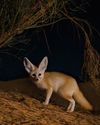DANCING IN THE DARK
BBC Wildlife
|July 2022
The long-wattled umbrellabird always eluded the limelight, until one photographer succeeded in bringing this striking avian out of the shadows

ENDEMIC TO THE CHOCÓ RAINFOREST OF Ecuador and Colombia, the male long-wattled umbrellabird is without a doubt among the most extravagant-looking birds of the neotropics. This handsome, black-feathered species looks most impressive during the mating season from November to February when his outlandish, Elvis-like hairdo expands over his beak, and his extraordinary wattle - resembling a phallic necktie - swells to twice its normal size.
Given its legendary looks, you may wonder why the umbrellabird has managed to evade the limelight for so long. It has never been photographed properly before and this has a lot to do with the hours it keeps, and the dark, dangerous neighbourhood in which it lives.
I first learned about the long-wattled umbrellabird in 1991, when I left South Africa for Ecuador and took up the job of creating the 21,000-acre Los Cedros Reserve in Ecuador's north-western Chocó. Thumbing through my bird guide, I chanced across a -reference to this mysterious bird and its ostentatious courtship display and decided it had to be seen to be believed.

It wasn't until 2001, however, that I actually set eyes on the species, having joined a scientist who had located a nest in the southern stretch of the Chocó, and needed images for his research paper. I'll never forget the thrill of being one of the first photographers to witness the first officially described nest of the long-wattled umbrellabird, complete with resident female.
Denne historien er fra July 2022-utgaven av BBC Wildlife.
Abonner på Magzter GOLD for å få tilgang til tusenvis av kuraterte premiumhistorier og over 9000 magasiner og aviser.
Allerede abonnent? Logg på
FLERE HISTORIER FRA BBC Wildlife

BBC Wildlife
"I was terrified the elephant would ram us"
African elephant in Kenya
2 mins
January 2026

BBC Wildlife
ALL YOU EVER NEEDED TO KNOW ABOUT THE Fennec fox
THE FENNEC FOX IS THE SMALLEST fox in the world, with a body length that can be as little as 24cm.
3 mins
January 2026

BBC Wildlife
INTO THE PLASTISPHERE
A unique synthetic ecosystem is evolving in our oceans – welcome to the plastisphere
7 mins
January 2026

BBC Wildlife
“More than half of all animal life exists in a parasitic relationship, and all life lives in symbiosis”
Our survival depends on species evolving to live together - but some relationships take dark turns
7 mins
January 2026

BBC Wildlife
Are animals able to dream?
SLEEP IS A MYSTERIOUS THING. FOR A long time, we weren't sure why we do it.
1 mins
January 2026

BBC Wildlife
Does a cuckoo know it's a cuckoo?
ABSURD LITTLE BIRDS ACROSS THE world lay their eggs in the nests of other species, leaving the hapless parents to raise a changeling at the expense of their own offspring.
2 mins
January 2026

BBC Wildlife
Orcas killing young sharks
Juvenile great whites are easy prey for orca pod
1 mins
January 2026

BBC Wildlife
Ocean goes on tour
Acclaimed film touring the UK, backed by live orchestra and choir
1 min
January 2026

BBC Wildlife
Feisty bats hunt like lions
Winged mammals use a 'hang and wait' strategy to take down large prey
1 mins
January 2026

BBC Wildlife
SNAP-CHAT
Richard Birchett on magical merlins, wily coyotes and charging deer
2 mins
January 2026
Translate
Change font size

